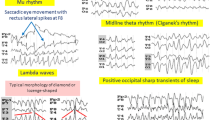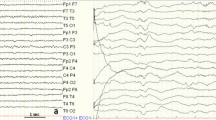Abstract
The diagnostic yield of the EEG is thought to be less useful in the elderly epileptic patient. This retrospective study evaluates the results of repeated EEG recordings in 137 patients aged 65 years or more, who were admitted to the hospital because of epilepsy or a first unprovoked seizure. The mean number of records was three during an average period of 7 days. Epileptiform activity was present in 39%, focal slowing in 28%, and 25% had normal recordings. In 9 of 31 patients, epileptiform activity was detected in a sleep deprivation EEG. Recordings obtained within two days after the last seizure showed more epileptiform activity than those with longer intervals. The frequency of epileptiform activity decreased with follow-up recordings, whereas focal slowing remained unchanged. These results are in accordance with the incidence and the follow-up of epileptiform activity in younger adult epileptic patients.
Zusammenfassung
Die diagnostische Aussagekraft des EEG bei Altersepilepsien wird geringer eingeschätzt als bei jüngeren Patienten. In einer retrospektiven Analyse von 137 Patienten über 65 Jahren, die wegen einer Epilepsie oder einem unprovozierten Erstanfall stationär aufgenommen wurden, wurden in einem durchschnittlichen Beobachtungszeitraum von sieben Tagen die Ergebnisse wiederholter EEG-Untersuchungen bewertet. Bei 39% fanden sich epilepsietypische Veränderungen ganz überwiegend als fokale Sharp-wave-Herde, bei 28% Herdbefunde ohne epilepsietypische Potenziale und 25% aller Patienten hatten einen unauffälligen Befund. Neun von 31 Schlafentzugs-EEG zeigten epilepsietypische Potenziale. Der Nachweis epilepsietypischer Potenziale gelang häufiger bei Ableitungen innerhalb von zwei Tagen nach dem Anfall als bei längerem Intervall. Während der Verlaufsuntersuchungen nahm die Häufigkeit epilepsietypischer Potenziale ab, während die Herdbefunde unverändert blieben. Diese Ergebnisse zeigen keine Unterschiede im Vergleich mit den Häufigkeits- und Verlaufsangaben in der Literatur bei jüngeren erwachsenen Epilepsiepatienten.
Similar content being viewed by others
References
Ajmone Marsan C, Zivin LS (1970) Factors related to the occurence of typical paroxysmal abnormalities in the EEG records of epileptic patients. Epilepsia 11:361–381
Bauer G (1975) Der Wert von EEG-Kontrollen möglichst bald nach einem epileptischen Anfall. Z EEG-EMG 6:125–130
Bora I, Seckin B, Zarifoglu M, Turan F, Sadikoglu S, Ogul E (1995) Risk of recurrence after first unprovoked tonic. clonic seizure in adults. J Neurol 242:157–163
Camfield PR, Camfield CS, Dooley JM, Tibbles JAR, Fung T, Garner B (1985) Epilepsy after a first unprovoked seizure in childhood. Neurology 35:1657–1660
Doppelbauer A, Zeitlhofer J, Zifko U, Baumgartner C, Mayr N, Deecke N (1993) Occurrence of epileptiform activity in the routine EEG of epileptic patients. Acta Neurol Scand 87:345–352
Donselaar van CA, Geerts AT, Schimsheimer RJ (1991) Idiopathic first seizure in adult life: who should be treated? BMJ 302:620–623
Drury I, Beyddoun A (1998) Interictal epileptiform activity in elderly patients with epilepsy. Electroenceph Clin Neurophysiol 106:369–373
First Seizure Trial Group (1993) Randomized clinical trial of the efficacy of antiepileptic drugs in reducing the risk of relapse after a first unprovoked tonic-clonic seizure. Neurology 43:478–483
Hughes JR, Zialcita ML (1999) EEG and epilepsy in the elderly compared to a younger group. Clin Electroenc 30:126–131
Hui ACF, Tang A, Wong KS, Mok V, Kay R (2001) Recurrence after a fist untreated seizure in theHongKong Chinsese population. Epilepsia 42:94–97
King MA, Newton MR, Jackson GD et al (1998) Epileptology of the first-seizure presentation: a clinical, electroencephalographic, and magnetic resonance imaging study of 300 consecutive patients. Lancet 352:1007–1011
Klass DW, Brenner RP (1995) Electroencephalography of the elderly. J Clin Neurophysiol 12:116–131
Lühdorf K, Jensen LK, Plesner AM (1986) Epilepsy in the elderly: Prognosis. Acta Neurol Scand 74:409–415
Neufeld MY, Chistik V, Vishne TH, Korczyn AD (2000) The diagnostic aid of routine EEG findings in patients presenting with a presumed first-ever unprovoked seizure. Epilepsy Res 42:197–202
Pratt KL, Mattson RM, Weikers NJ, Williams R (1968) EEG activation of epileptics following sleep deprivation: A prospective study of 114 cases. Electroenceph clin Neurophysiol 24:11–15
Ramsay RE, Pryor F (2000) Epilepsy in the elderly. Neurology 55(Suppl 1):S9–S14
Ramsay RE, Rowan J, Pryor FM (2004) Special considerations in treating the elderly patient with epilepsy. Neurology 62(Suppl 2):S24–S28
Salinsky M, Kanter R, Dasheiff RM (1987) Effectiveness of multiple EEGs in supporting the diagnosis of Epilepsy: An operational curve. Epilepsia 28:331–334
Sirven JI (2001) Acute and chronic seiures in patients older than 60 years. Mayo Clin Proc 76:175–183
Stoink H, Brouwer OF, Arts WF, Geerts AT, Peters ACB, van Donselaar CA (1998) The first unprovoked, untreated seizure in childhood: a hospital based study of the accuracy of the diagnosis, rate of recurrence, and long term outcome after recurrence. Dutch study of epilepsy in childhood. J Neurol Neurosurg Psychiatry 64:595–600
Thomas RJ (1997) Seizures and epilepsy in the elderly. Arch Int Med 157:605–616
Werhahn KJ (2004) Epilepsie im Alter. Klinische, epidemiologische und pharmakotherapeutische Aspekte. Z Epileptol 17:187–198
Author information
Authors and Affiliations
Rights and permissions
About this article
Cite this article
Besser, R. EEG bei Altersepilepsien. Z. Epileptol. 19, 6–10 (2006). https://doi.org/10.1007/s10309-006-0159-3
Received:
Accepted:
Issue Date:
DOI: https://doi.org/10.1007/s10309-006-0159-3
Key words
- Epilepsy in the elderly
- EEG recordings
- incidence of epileptiform activity
- follow-up investigations
- comparison to younger epileptic patiens




